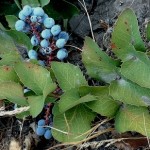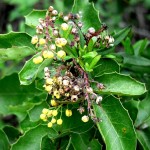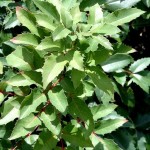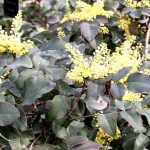Oregon Grape Plant – Mahonia repens
|
Current Demand = Normal |
Parts Used: Root & Root Bark |
 |
 |
 |
 |
Family: Berberidaceae
Common Names: Creeping mahonia, Creeping barberry, Creeping hollygrape, Ash barberry, Oregon grape or Holly grape.
Description:
Oregon grape herb is an evergreen perennial shrub that is a low growth plant. The leaves are dull green on the top with a whitish bottom, with 3-7 toothed leaflets that are 1-3 inches in length. They remain on the shrub all year and have a deep burgundy overtone in the fall.
The flowers are small and yellow, appear in clusters and bloom in the late spring. They are scented and hermaphrodite. After the flowers fall, fruits of blue clumped like grapes appear. The roots are shallow, lateral and finely fibrous and have been known to grow up to 6 feet. Growing region: The Oregon grape herb has been found throughout the western U.S. from Texas north to British Columbia and Alberta. It can be found on slopes facing the north, in pine woods, area of dappled shade, woodland gardens and in areas where Douglas firs grow.
Harvest/drying:
Parts Used: root, root bark
Harvest the root in autumn or early spring. The rootstock and root are knotty, irregular in shape and length and have a diameter of one inch or less. It is hard, with brownish bark and a yellow tinge wood covering. The root has a slight odor and taste bitter. Gather the larger more mature roots leaving plenty of younger smaller plants to seed the area for future harvest.
After harvest, remove all foreign matter (rocks, weeds and other roots) and spread in a thin layer immediately. When possible dry indoors in a well ventilated barn loft or attic to protect from the elements. If natural heat is not available you may need to add heat and a fan for continuous airflow. Whether you dry indoors or outdoors you will need to turn or stir the root daily. The key to drying any root, herb or bark is an even combination of heat and airflow. Never dry in an oven or microwave. The root will be completely dry (largest stem will snap not bend) in 3-7 days depending on the drying conditions. Once it is dried place the roots carefully into a cardboard box or paper bag for storage in a dry area until you are ready to sell or use. Never store Oregon grape herb/root in plastic or it will mold.
Cultivation/Planting
Oregon grape herb prefers sandy, loamy and clay soils that are well drained and moist. It can grow in either semi-shade or no shade.
Propagation Seed: seeds are best sown as soon as it is ripe in a cold frame. Prick out the seedlings when they are large enough to handle and grow them on in a cold frame for at least their first winter. Plant them out in late spring or early summer.
Division: divide the suckers in spring when they can be placed direct into their permanent positions. Better results occur when they are potted up and placed in a frame until established then transplanted in the late spring or early summer.
Attributes (Images)
By Stephen Lea (Photograph by Wikipedian) [GFDL or CC-BY-SA-3.0], via Wikimedia Commons
By Denis.prévôt (Own work) [GFDL or CC BY-SA 3.0], via Wikimedia Commons
By André Karwath aka Aka (Own work) [CC BY-SA 2.5], via Wikimedia Commons
Stan Shebs [GFDL, CC BY-SA 3.0 or CC BY-SA 2.5], via Wikimedia Commons
 Root Buyer
Root Buyer